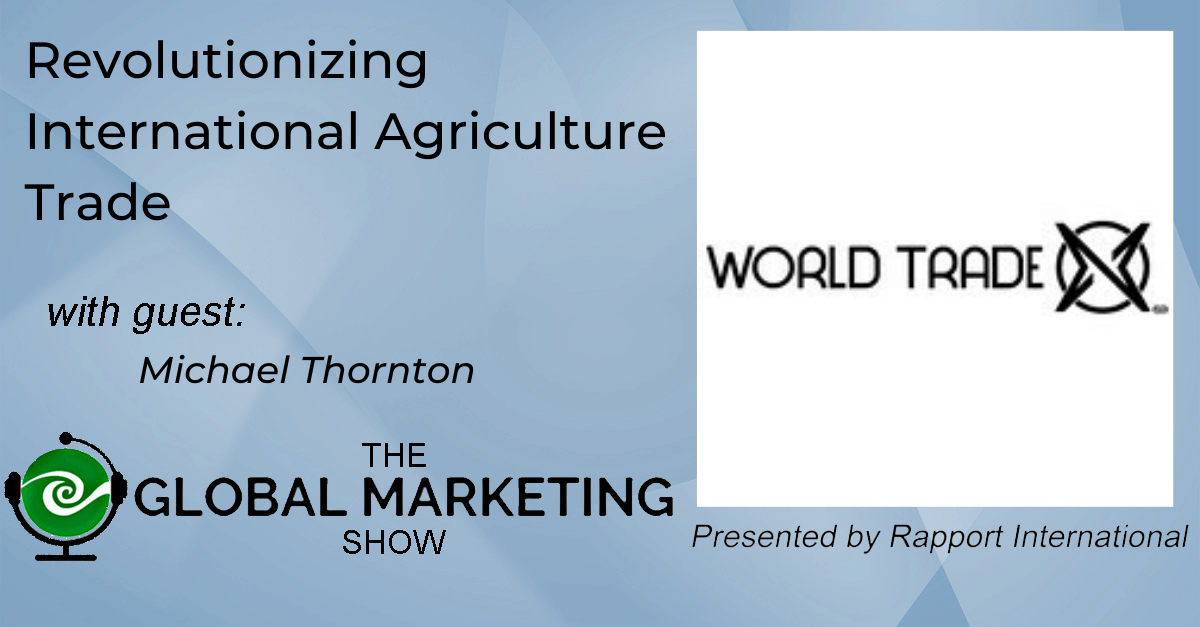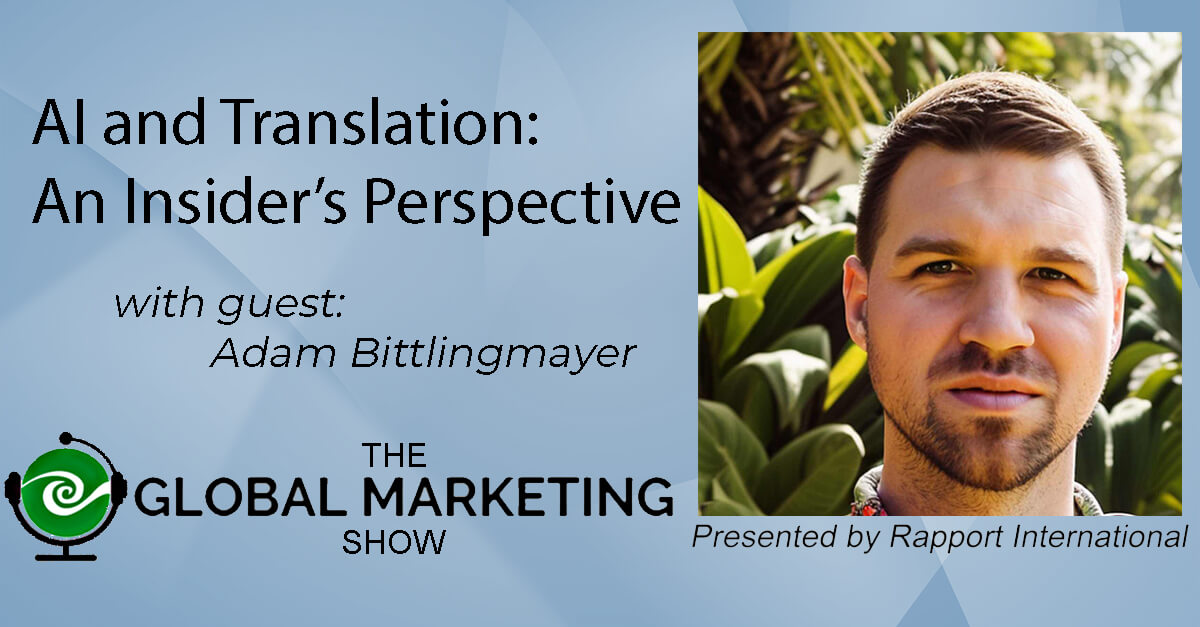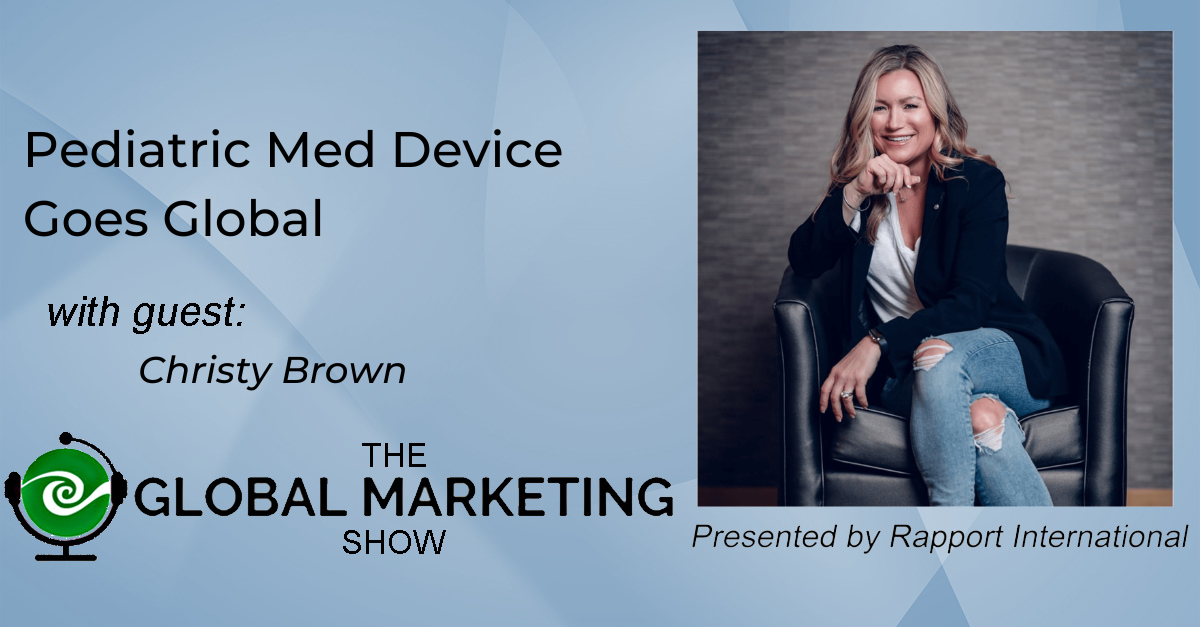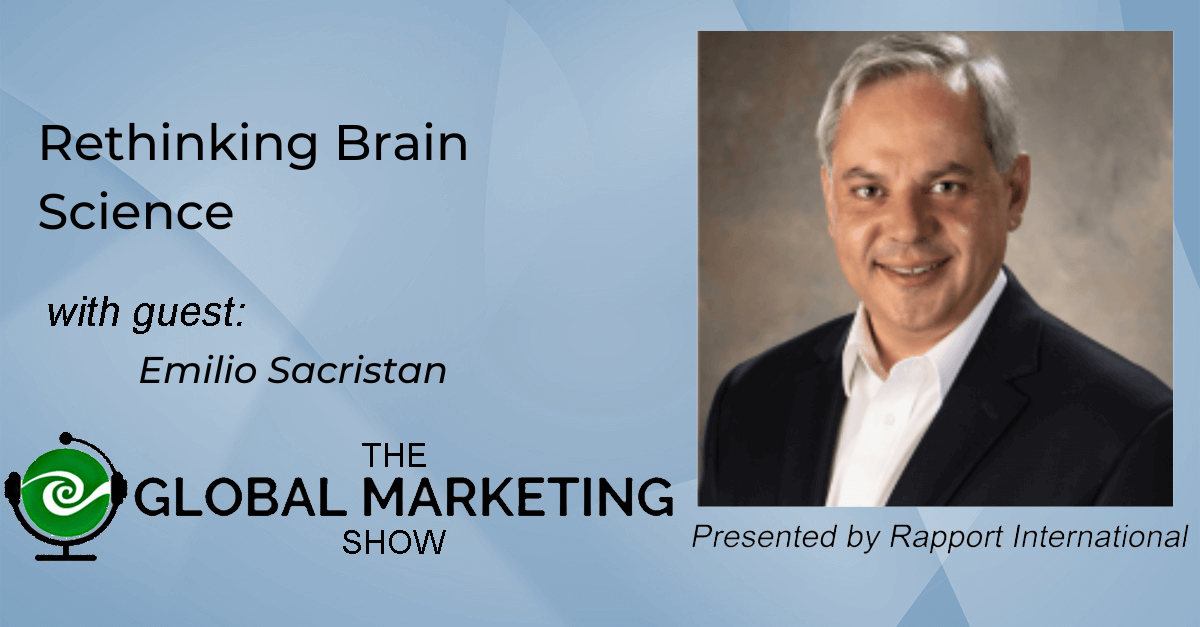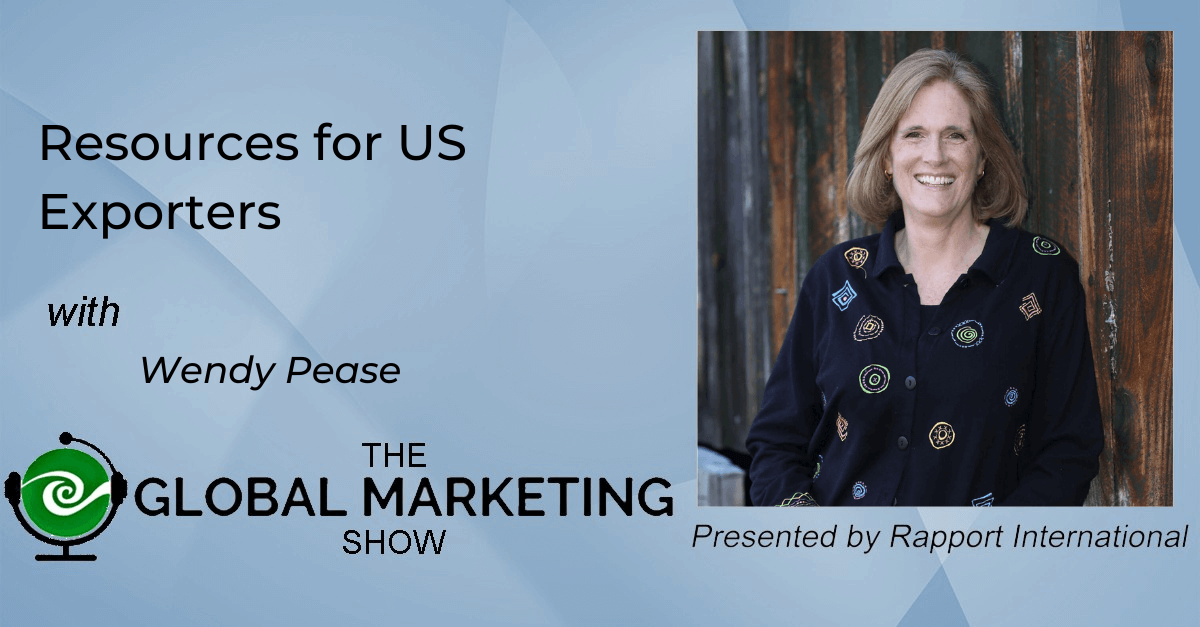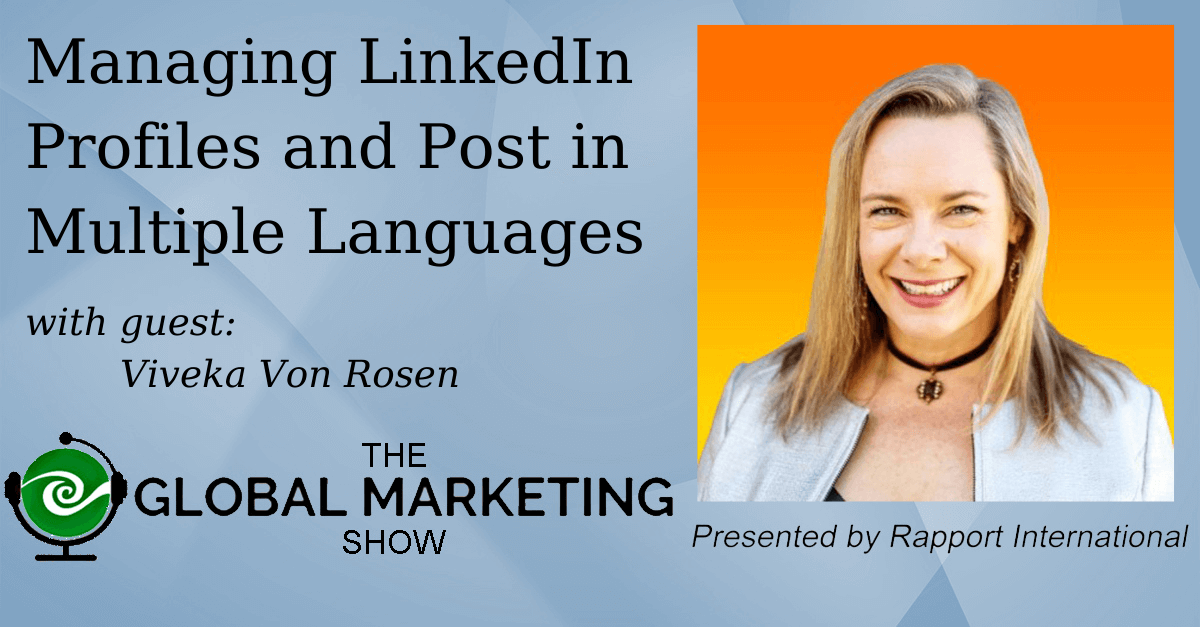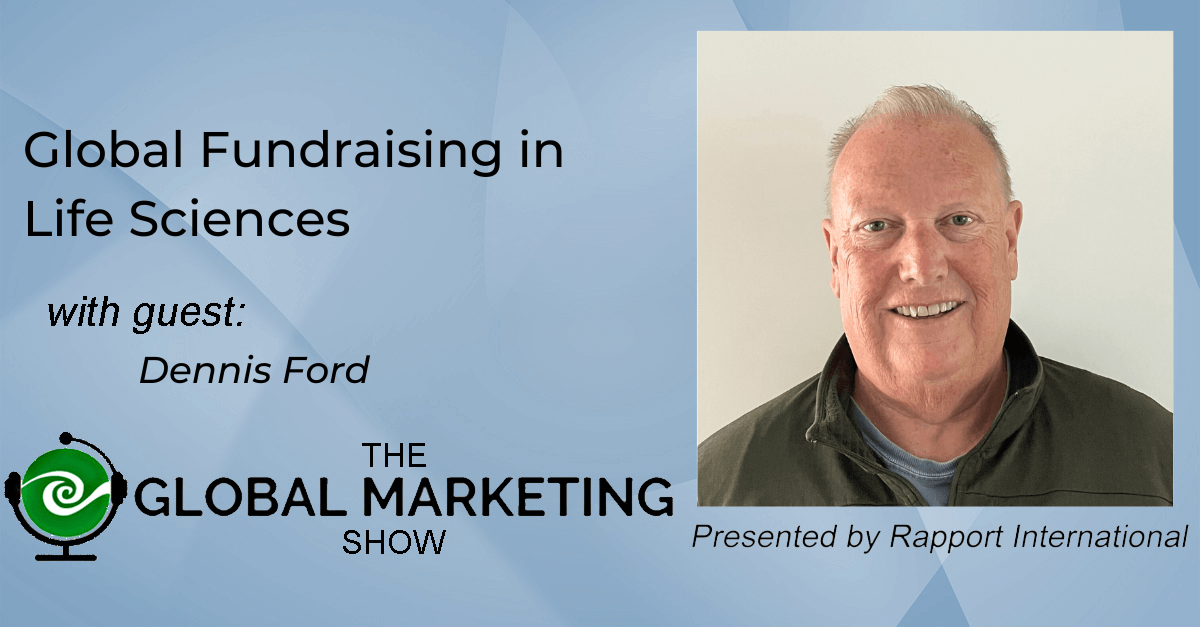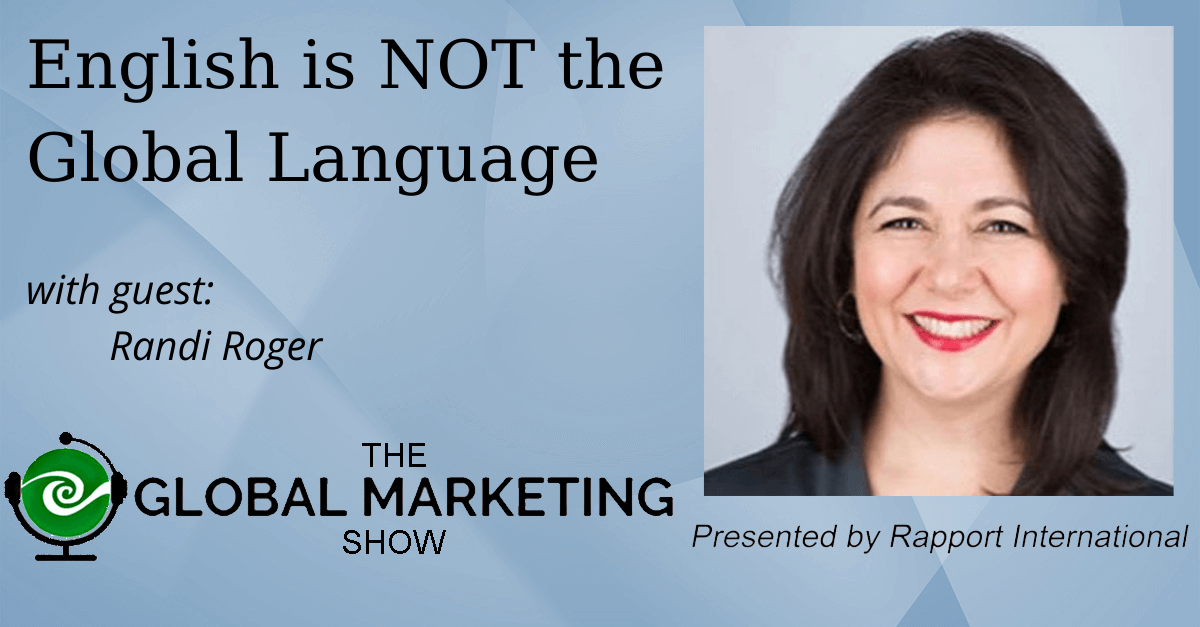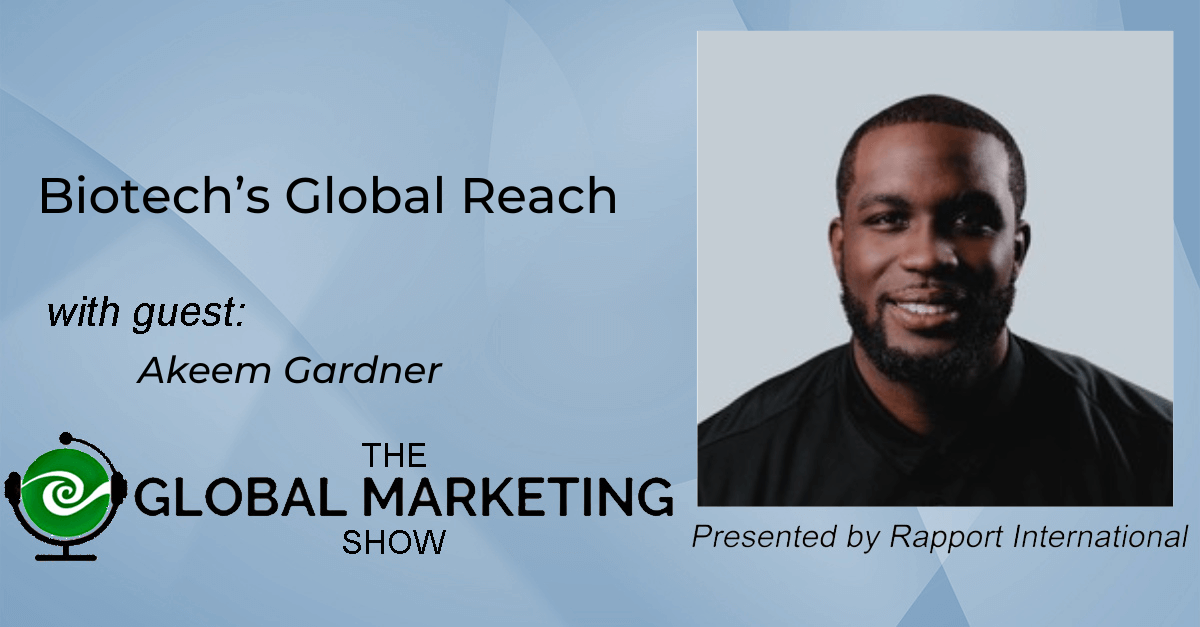Amy Kenigsberg, Cofounder and COO of K2 Global, joined me on The Global Marketing Show to discuss WIIFM (“what’s in it for me?”) communications, cultural messaging, and ChatGPT. K2 focuses on precise, nuanced messaging to impact everyone involved in the purchasing process, a strategy especially critical within account-based marketing (ABM). To that end, Amy developed a process that her agency uses to build a “Bible of Messages”: starting with the engineers from its technology company clients, K2 translates all the features and benefits of the “tech talk” into “marketing talk,” which is then customized to each of the decision makers in the buying process.
They then test rough draft messaging across industries, roles, and geography to validate the messaging specific to each player, driving each to emotionally connect with the client’s brand.
Continued client support combines K2’s Bible of Messages with the PESO Model™ developed by Gini Dietrich, of OBI. The PESO Model™ integrates and optimizes use of the four media types – paid, earned, shared, and owned. Building the Model based on specifics from the Bible of Messages accelerates the end-result of helping companies build authority and thought leadership more efficiently.
Recently, clients have asked Amy about ChatGPT and its ability to write content. Like many content creators and translators, we are watching the technology to see what it will do to our respective industries, and here’s what we’ve seen so far.
The good:
The speed and ability of ChatGPT is amazing and it’s great at smashing writer’s block. It can clearly develop a thoughtful flow to the content for an initial “pre-draft” (rather than a “rough” draft, which is simply putting ideas on paper). It gives great ideas for short content like social posts, it corrects grammatical errors, it eliminates boring rote tasks.
The Bad:
The program pulls from historical content, so even if it’s dated, ChatGPT makes it seem current, and real. Add to that the seemingly worldwide trend toward a “post-fact” culture and it’s easy to imagine how the continued recycling of inaccuracies could kick-start the multiplier effect of a world operating on widespread misinformation.
The content is consolidated, with neither source nor attribution to the original writers. When we write and publish, we cite our sources to add legitimacy to our work. Hopefully, the tide will likewise demand and formalize citation of content from any automated source.
Its ability to adapt the tone of its output to the intended purpose is still limited. With the lack of emotion, ChatGPT content can get boring to read. It may make sense to use it to generate an automatic first draft and then edit for nuance, urgency, and other emotional cues, but outside of potentially helping with a writer’s block, it wouldn’t necessarily save time.
The Ugly:
Have you ever heard of the Infinite Monkey Theorem? It states that a monkey hitting keys at random on a typewriter keyboard for an infinite amount of time will almost surely type any given text, such as the complete works of William Shakespeare. Amy compares ChatGPT to this theorem! Given enough tries, maybe the program can come up with a creative story that encapsulates your marketing message with enough emotion to capture your buyer’s attention.
The Concerns:
Amy describes her additional concerns:
On his Revisionist History podcast, Malcolm Gladwell explained the difference between an anecdote and a story. An anecdote talks about something that happened: “I went to the store and used a $5 bill to pay for the items I bought.”
A story adds some spice to the anecdote: “I went to the store and tried to pay for my items with a $5 bill. The shopkeeper laughed and threw the bill back at me.”
(OK, I edited it a tad from the podcast, but you get the idea.)
In essence, an anecdote recites; a story keeps you interested, and you want to know more.
ChatGPT can produce anecdotes; creative writers tell stories.
Good marketers are creative writers.
Perhaps inspired by our conversation, Amy says her favorite foreign word is the noun “balagan,” which is Hebrew for “mess”!
Links:
Websites:
Company Social Media:
https://www.linkedin.com/company/k2-global-communications
https://mobile.twitter.com/k2gcomm
https://www.facebook.com/K2GlobalCommunications
LinkedIn: https://www.linkedin.com/in/amykenigsberg/
Connect with Wendy: https://www.linkedin.com/in/wendypease/
Music: Fiddle-De-Dee by Shane Ivers https://www.silvermansound.com
ATTENTION: Below is a machine generated transcription of the podcast. Yes, at Rapport International, we talk a lot about how machine translation is not good quality. Here you see an example of what a machine can do in your own your language. This transcription is provided as a gist and to give time indicators to find a topic of interest.
Wendy: Hi friends. Thanks for joining us on another episode of The Global Marketing Show. I am so happy that you're here and I'm so excited about this conversation cuz it's gonna be very topical. We're gonna get into how you can send mixed messages across cultures and how to communicate across borders.
But on this, we're also gonna [00:01:00] touch on some ChatGPT and what that's doing to writing and translation. So, as you know, or maybe you don't know that The Global Marketing Show is brought to you by Rapport International, who connects you to anyone anywhere in the world, across 200 languages with a hundred percent guarantee.
And we have a Tidbit from Rapport International today. It's about being shocked or being in agreement. So raising your eyebrows to an American conveys that you're surprised by something or skeptical. But if you give the same facial expression, to a Greek, the raised eyebrows will, I mean like a yes, I'm in agreement with you.
So make sure that you're communicating clearly across borders and cultures. So today I'd like to welcome Amy Kenigsberg. So Amy, thanks for being here. I'm excited for our conversation. [00:02:00] Amy is COO and co-founder of K2 Global Communications.
It's a global marketing PR and content agency based in Israel. They're HubSpot partners, and that's how we've gotten the chance to connect. K2 works with clients and media all around the globe. Australia in the morning, Silicon Valley at night, and all points in between. She ensures her clients focus on what's in it for me, communication.
So we'll have to ask about that. And that's clearly communicating the benefits of their technologies, not just what they do. So Amy, welcome, welcome.
Amy: Thank you very much. It's great to be here. I'm rather excited.
Wendy: Good, can you tell us more about what's in it for me? Communications. I like the way that you say that.
Amy: Sure. Basically it's describing the benefits that each of the people who would be touched by your technology will get. And what we mean [00:03:00] by that, it actually integrates some of the philosophy of account-based marketing. Although we've been doing this well before the account-based marketing lingo came into being.
Basically it's determining who in the organization is touched by the sales process and outlining the benefits to each of those people for your technology. So, for example, a cybersecurity product. The CISO might be the one signing on the bot dotted line, but you might have to go through purchasing.
Be having to work with the team in the security operations center, you might be having to work with the database administrator. If it's a database security product, you might be needing to work with the head of r and d if it's a security product for DevOps. So what we try to do with our clients is make sure that they understand all of the different roles.
That are touched in the organization and what benefits those people are going to get, whether direct or indirect, by using their product. Not, Hey, our product is A, [00:04:00] B, C, or D and you'll love it. It's our product lets you sleep at night. Our product is 10% less than causes, 10% less, fewer issues than our competing product.
So you're gonna save money. on hassle and time, we replace 10 other products, so the licensing fees will go down. So it's basically every benefit tied to each role within the organization. Can you gimme
Wendy: an example of client that you worked with that in and spoke mostly about features and had multiple buyers?
in their target organizations and how you converted that to benefit speak. Sure.
Amy: Or what's in it for me? Yeah. So basically it's really a matter of working with the team and developing the personas and one of the things we like to do. [00:05:00] Can you think
Wendy: of a specific story of how you did that?
Amy: Sure, sure.
Absolutely. We had a client that said, , well, we have the best product on the market. And it was like, okay, that's well and good, but when we Google you, you end up on page six. Nobody knows what you do. Nobody knows the benefits that they're gonna get out of that. So we worked very closely with the client and really mapped the people.
It was actually a product that had to do with. mapping uh, radar, which is like radar, but with lasers. And so they had all sorts of different niches they worked with. They had all sorts of different clients within those niches. And we really mapped, you know, their agriculture clients, their city planning clients, and really put down and said, This is what you're doing.
But you know, the city planners, they're gonna [00:06:00] get more insights into the terrain that the city is growing into. The ag people will get to know more about what's going on in the fields based on the data they're getting back. So it had to be very specific per client per. .
Wendy: Okay. So that's really interesting.
Now I'm, I'm seeing a big grid form in my head cuz you had across industries, but then you also had about a across countries. So how did the messaging change in one of the examples of the industries across the different countries?
Amy: So, so really it's understanding the, the language of the countries. It's very kind of funny in.
Hebrew, there's a word called tacos, which the American translation is basically getting down to brass tack. And so the Israeli market, for example, wants very specific points. I wanna know, does it do this, this, and [00:07:00] this? Is it gonna benefit me here, there? And the other thing the American market is very much benefits focused as well.
But on the American side, things are focused on cooperation. So for example, it might be how will this help the organization work together better versus how is this gonna help my department? So it's really examining the culture of, you know, so for example, unity, the former Soviet block countries are still also.
you know, the, even though the Soviet block is gone and back again, . Um, but that's a whole other story.
Wendy: I, I laugh with uncomfortable, not funny.
Amy: Yeah, exactly. Or like in Asia Asia is very much a cooperative society. So in that case, again, it's focusing on the cooperation and the benefits the organization will get as a whole, whereas other countries are, , I need this for my department.
What am I [00:08:00] gonna get out of it? And they're not really focused on the organization as a whole.
Wendy: Now, do you have a process when you're working through this with clients on how to think about it?
Amy: Yeah. So it's, it's actually kind of interesting because we start with the bottom down or I guess the bottom.
when we work with a company, in addition to meeting with, you know, the senior management team and the people who are affected within the organization, by our, you know, that we work with directly, we like to speak with the engineers because they really understand the product and because I have a good mind for technology, I.
then be the translator, no pun intended with your business , but be the translator of the technical benefits to the marketplace. So I take what the engineer says. We take what the engineers have said, we take what management has said, [00:09:00] we do external research, and then we put together basically what we call the, the bible of messaging.
And that is a document that could be three pages, it could be 15 pages, and it. in depth on the benefits to the companies, the benefits to the people, and the benefits of each product feature. You know, there, in addition to the overall, there are certain product benefits. That are only gonna affect one department or another, like a cybersecurity product.
There might be some aspects built in for compliance. There are other aspects built in for security. There's other aspects built in for privacy. So in addition to, you know, the big picture of the product, it's also which feature gives which benefits to which audiences. Okay. So
Wendy: you start with the engineers and then you get this bible of messages, and then what's the next step?
Amy: So then the me next step is [00:10:00] integrating those messages into the communications, you know, whether it's region, industry role. and it's defining who's gonna hear what. And then, you know, it's traditional communications. But we like to quote Ginny Dietrich and her peso model, which is paid, earned, shared, and owned, which is using, can you repeat that?
I didn't hear that clearly. Sure. Ginny Dietrich in Chicago of Spin Sucks, has created a model called Peso, which is paid, earned, shared, and, And it's a way to create metrics around your communications, but it also helps you use all of the channels most effectively. To take the American motto, reuse, reduce, recycle.
We do the same thing with the messages. You know, a message. , we, we might write a blog that's focused on one message and then we'll amplify that blog using social media. We'll revise that blog [00:11:00] to become an article for a publication. Now, in the previous lives of, what, six months ago? We would do all those rewrites ourselves.
You know, now we're having clients request that we uh, do things through our new friend Chad. Which does give a decent first draft or a, I guess I almost wanna say a pre-draft. It helps correct it, it puts the ideas on paper, but then you need to review it very closely to make sure that, number one, the ideas are correct.
Because technology changes so quickly. And even though 2 20, 21 was only two years ago, things have evolved fast enough that the information may not be correct. . You also need to make sure it matches the tone of the organization chat. G p t is very stilted, very formal, and you know, it's kind of like, and the cat and the hat jumped.
over the [00:12:00] roof. Whereas it might be, Hey, you know, we're a company that has cats and hats and chats and we like to put it together. So you really need to create content with the right tone for the right organization. You know, you can only be formal and stuffy for so long, and there's not really a lot of creativity.
In there you can say, okay, write something with attitude. But again, attitude changes from country to country. Culture, culture, region to region. I mean, I grew up in New Jersey and then I went to high school in Texas and just the inter US culture shock of a small town in New Jersey to Houston, Texas, the fourth largest city in America.
and so everything really needs to be read for culture and tone, correctness, making sure there are no biases in there, and making sure everything is [00:13:00] really on message to what you want your company to be and what you wanna present to the market. . So where do
Wendy: you see this going in your industry? If people are saying use chat g p t, is it really good enough for you to you to use as a first draft to modify for tone, attitude, culture
Amy: bias?
It's good enough for a pre-draft. Like some people just can't stare at a blank sheet of paper and they get writer's block, or I guess not paper anymore. Can't stare at a screen. Right. Um, and writer's block. So it's good for. giving you a preliminary outline or, you know, very short content, like write me a social post that talks about cats.
You know, that's something very basic, but really it's not mature enough to. Be something that I would be proud of to just post, Hey, chat, G p t wrote this and let's [00:14:00] post it. It's, you really need to look at it in depth and make sure it's really what you wanna say. Yeah, you,
Wendy: you know, it's interesting, there's a lot of parallels with writing and translation cuz translation takes the same amount of time as it does to write something.
You're not starting with a. Paper or screen. You've got something there, but it takes thought and it takes an understanding on how to get the message across. And you know, I mentioned to you that somebody asked chat, g p t, what could go wrong if a human does not review translations created by chat G P T that were then published and just what you're talking about it.
Accuracy is number one. It could be factually incorrect or misleading. Fluency is the second issue. Difficult to understand or don't accurately convey the intended meaning. Number three is bias. It could lead to biased or offensive translations [00:15:00] being generated. Number four is legal risks. It could provide.
Translations that are factually incorrect or defamatory. So that, you know, just as you're talking about the writing chat will even chat. Two PT will even tell you that there is problems with the translation. I also worry about copyright, confidentiality, ownership. You know, can you talk to me about some of those things that, that you're thinking about?
Amy: Yeah, sure. So, basically, Chat. G p t is learned by anything that's public record, whether it's things people wanna have on public record or not. I mean, the best example I can think of is years ago my husband's friend's daughter posted some photo on social media of her on the toilet, and we basically called like, you know, you could see there was nothing obscene showing, but you saw where she.
And he basically called [00:16:00] her and he is like, you need to take that down immediately. That's gonna haunt you the rest of your life. And so there are facts out there that may not be as fact not factual, but you know, there might be defamatory content out there that's being used. If, you know, if you wanna write a biography of someone using chat g p t, there might be.
Facts out there that are not correct. I know I just recently read an article about all the misleading things that were coming up in, uh, Google's chat product and the misleading information that was coming through on some of the others. So facts really, you know, I know we're in quote, a post fact culture, but there's still facts.
There are still proven things that are black and white and if they're not right, you know, , you don't wanna look stupid. And then the other part, again, all of this is getting recycled. So if you have a social post [00:17:00] that's wrong, it's gonna be sucked into some other machine learning tool that's gonna say, oh, here's something that somebody posted.
It must be true. And that information is gonna keep spreading around and spreading around. and it, it's gonna, it's a multiplier effect, you know, it's like a very, very dangerous game of telephone. You know, we've all played that game.
Wendy: Yeah. You know, it's it's making me think about kids in school where they can use, you know, there's all this worry about education and how kids are gonna write their papers using chat.
G P T I can read it and know, oh, this is very boring and it's very structured. So there's none of that creative writing or emphasis. And so, but you know, a teacher who's grading 30 papers, You know, probably eventually we'll get to the point of picking it out or they know their kid's style of writing or essays are gonna be done in class, on paper, [00:18:00] on those old, you know, essay books.
But , you they learned to source their content and my kids were never allowed to use Wikipedia as a source. And so I heard another podcast interview that they were talking about, that if you do write something on chat g p t, you've gotta, you've gotta write the source or the author for that and not take credit for it.
So it is, I mean, that multiplier effect and, you know, incorrect sources. That, that gets scary.
Amy: Oh, definitely. I mean, I'll never forget in college I wrote a paper and I was one of those people who would go to the library and like photocopy everything and then, you know, put it all together and I got a note back from a professor.
He's like, you quote so many people here and you have so many sources, put it together. You know, cause I was so concerned about accuracy and making sure that, you know, my facts were correct. And I was like, okay, this person said this and this person said that, you know, attribution [00:19:00] disappears. Cuz I, I actually asked Chachi PT to do something.
I'm like, I need these statistics. Oh, this was actually very interesting. I asked chat, g p t give me the latest sales and marketing statistics. The first time I. , it said, I only have data from 2021 and before, here's the data. The second time I did it, it didn't give me that disclaimer. Oh. So I thought, and it was similar, it was the same information, and I was like, okay, so I guess I'm supposed to follow these links and discover they're.
But I, I was like, okay, so it's even not telling the truth when I ask it the same question. So I found that kind of scary.
Wendy: So it's inconsistent Yeah. And how it's pulling up information. Yes.
I, I, I don't even know where to go with that. . Yeah. I thought would be pretty similar, particularly if you [00:20:00] ask it the same question. Yeah, so, so where does this go? Do, I mean, will PE will buyers look at websites and say, this is boring, therefore I'm gonna go away? I mean, yes. You look at the companies who have done well, they have a good story and they connect with their buyer.
Amy: Exactly. It's still storytelling and. , you know, a beginning, middle, and an end. And yes, chat, g p t can, uh, give you a beginning, middle, and end, but it may not be the beginning, middle, and end that you wanna hear. Actually it was very funny. I was listening to a podcast earlier today, uh, revisionist History their live show, and they were talking about endings and Malcolm Gladwell gave something very interesting.
He said, an anecdote is, I went to, I found a hundred dollars. and I g on the street. And then I saw a homeless person a block later and I gave it to him. He said a story is I found a hundred dollars in the street and I gave it to a [00:21:00] homeless person and he threw it back at me and said, I don't wanna take your money cuz he said A story gives you something you're not expecting.
At the end. I thought was kind of an interesting definition of the difference between an anecdote and a story. I'd never heard that.
Right. And
Wendy: that's, and I don't think, well, it's interesting with chat, G P T I picked up three random words. I can't even remember what they were. I, I saved the poem somewhere and I said, write me a poem with these three random words. And the poem was actually pretty good. So there's that fine line between.
That unexpected in a story versus the anecdote? Yes, it followed a pattern for a poem and it incorporated those in and figured out a relationship between the words that I might not not have gotten to, but as a creative writer writing a poem, it's gonna pull [00:22:00] in Shill Silverstein, who is completely random.
You don't know, or Dr. Seuss, you don't know where they're. . It's always something new
Amy: and fun. Yeah. And then the other thing is there's no emotion in chat G p T, cuz if you're writing a poem, you know, it might be good the, you know, a B, B A or you know, a B, B, A C, a B, B a C. Like I've seen, you know, the sonnets, it's written.
But maybe I'm just too human. But even when I'm writing something technical, There's some sort of emotion involved because I'm picturing my audience, what do they wanna learn? What do they wanna know? You know, again, the what's in it for me? I'm writing something. What's in it for my reader? Right? You know, I'm not just putting it out there.
So I have specific keywords. I mean, it's very important for SEO to have specific keywords. , you don't wanna just have a document of keywords you want it to [00:23:00] have. What what I actually learned in journalism school, which is now officially called utility journalism, they called it news you can use, and we've been focused on that for years.
It's what information can you impart that's gonna help somebody improve their life, do their job better, et cetera. And when you write, you need to keep the audience in.
Right.
Wendy: Okay, so that's, if you want to write for a search engine without a motion key load, word it up and not connect with your buyer. You can use chat
Amy: G d P, that is perfect. But
Wendy: if you want your buyer to enter their credit card or attend a sales demo, , you've got to hit that emotion or that story to engage them.
Exactly. Yeah. So is our job. Are our jobs, as [00:24:00] you know, a creative person and a representative of translators around the world, is our job to educate people on the appropriate places to use this or figure out how to bring it into our business to make us more efficient?
Amy: I would say both. I would definitely say both, because there are times when you need to write something quickly or again, like you're writing something.
and you want to rewrite it in different words, you know, that sort of, I almost wanna say it's good for rote tasks, but nothing that you're gonna really say, wow, that was really creative. I really liked that. You know, there's that old expression if you, what is it? 13 monkeys Typewriters for 15 years or something.
Eventually they'll write Shakespeare. Yeah, I don't remember. I, I don't know where that came from. I've always known that it's something about monkeys with typewriters [00:25:00] and Shakespeare. So it had to be pre-computer saying, so I almost feel like, you know, chat G p T is the monkeys with the typewriters.
Yes. Eventually it will write Shakespeare, but I don't know how soon that will be. And will it touch people emotionally? Yeah. You know, there's still to be or not to be. That is the question. I mean, that's, 500, five or 600 years old already. And yet that is still something that every one of us can hear and feel, you know, cuz it speaks to us.
Yeah,
Wendy: yeah. Right. So can chat g p t do that? I don't know. I don't know.
Amy: And the day can, you know, there's no jobs for any of us.
Wendy: And I, you know, I go back to, we were talking about Google Translate before we started recording, and you know, this feeling I have with chat G p t is similar. [00:26:00] When Google Translate came out and people were trying to figure it out, it it did not put translators out of business.
It increased the amount of. Available because all of a sudden people are going, oh well a foreign language in a different culture isn't so scary to me anymore cuz I can get the gist. I know if you're being offensive to me or you're trying to be nice. And so people use Google Translate to get the gist to have casual cab, you know, Uber conversations.
But then People realized that there was a difference between a human and a machine doing it, and with all the differences there are in languages. So more, we've had more questions about do you do human translation? Do you do high quality? And so I'm just, you know, from what I'm seeing, chat, g p t isn't gonna take over high quality language to language communication on things that matter.
And that's what you're seeing in the writing too. [00:27:00]
Amy: Definitely it's, it's gonna be there for rote tasks or, you know, simple things, but you still need a person,
Wendy: right? . Right? And so how do you use that and let alone trying to get on chat G P T, I've tried multiple times and haven't been able to
Amy: take it
Wendy: on, so maybe I need to pay the $20 a month so I can access it whenever I want.
I don't even know if that's possible at this. This point in February of 2023. Exactly. So I always like to you know, kind of end the, the podcast with Do you have any recommendations on global marketing for our listeners?
Amy: Let's see. It's, it's actually I'm in a very unique chair because I'm based in Israel, but most of my clients are selling abroad.
So when. You're we're, we're sort of the, the international translator for them. [00:28:00] So really the best way to get to know a culture and know how to sell is reading and research. Go to similar companies of yours that are based in different countries and see how their messages are communicated. See what kind of things they're writing about, because that'll give you information about what your potential customers wanna hear.
It'll give you an introduction to that industry's culture. Also, you know, old fashioned read, read the magazines and websites for those countries and those industries. So for example, if you're selling something in the Caribbean, and it's hotel software. You have to understand that Mo, you know, the, the basics, the Caribbean hotels are mainly for tourists.
You are selling to a hotel in Midtown [00:29:00] Manhattan that's really focused on the business trade and international business travelers. You know, then it's okay. You, you need to again, shift for the right audience based on what you're looking for and what you're looking.
Wendy: Yes. That's really good advice. It's, it's going back and understanding your consumer before you start trying to sell them.
You wanna connect with them. Yeah. And do you, what's your favorite foreign word?
Amy: My favorite foreign word? Actually I can tell you, it's GaN. Is Hebrew for Mess. I was actually told that it's an Eastern European word that ended up in, uh, Hebrew, but it's like, oh, what a bogon. And it just says, mess So much better than the word mess.
I, I do love that. That has a nice ring to it. Yes. So you go into [00:30:00] your kids' room. Oh my God, what a ball. Ofone, because it, it, it, it gives you the emotional baggage of.
Wendy: Yes. Yes, exactly, which is what we've just been talking about is emotion and you gotta get that in there, bogon. I love
Amy: it. . Yes. So that is my favorite word.
Pardon? I said yes. That's my favorite Hebrew word. Bogon. That's
Wendy: a good one. Where people reach you if they'd like to talk to you more.
Amy: Sure. Amy, Ken, and that's k e n i g s b e r g K2 Global Communications. You can look for me on LinkedIn and my email is right on this picture, amy k2 minus gc.com. So.
Feel free to reach out. We have a US phone number so you can call anytime, just not after 10 o'clock eastern time and, uh, . Okay. I'm glad you time is horribly early in the morning, [00:31:00] not after, uh, 2:00 PM Eastern Time. Okay. . Not
Wendy: after 2:00 PM Eastern time. You're, you're not gonna find her then. But yeah.
Your email is good in LinkedIn. I am glad you said it because a lot of people will be listening to this. So it's Amy a m y at k, the letter, the number two dash G as in George, C as in com. Dot com. Yes. Uh, so Amy, thank you so much for coming on the show and sharing this. Thank you. Discussion was very
Amy: good.
I had a good. Thank
Wendy: you. All right my friends, thank you for listening. If you found this conversation interesting, please give it a five star rating and share it with somebody that might be interested in hearing about it too. We've, we've grown, we're now in over 80 countries. I think the count is up to 88.
So we appreciate you listening and sharing. And we'll talk to you next time. Thanks. Bye-Bye.
[00:32:00]
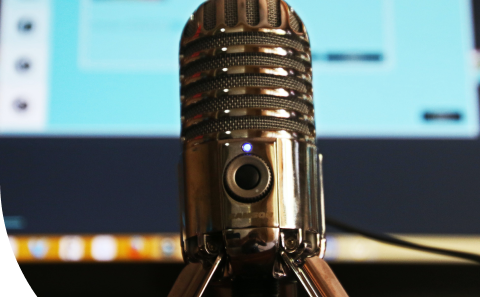
Are you a global marketing professional with stories to share?
Popular Posts
Popular industry news, interviews, technologies, and resources.
